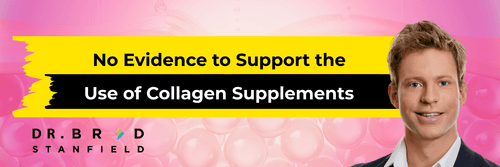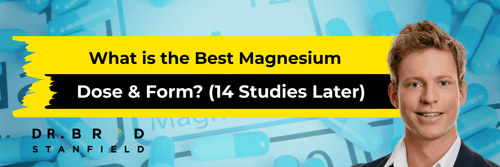Riboflavin is a key vitamin in the bodily processes that help transform carbohydrates into energy for your body to use. Like most vitamins, your body can't make it on its own, classifying it as an essential nutrient you have to get from food or supplements.
What is riboflavin, what does it do specifically, and how much do you need? How can you tell if a multivitamin you're taking is giving you enough? Let's start at the beginning.
Table of Contents
- What is Riboflavin and What Does it Do?
- How Much Riboflavin Do You Need?
- What Are the Symptoms of Riboflavin Deficiency?
- Where is Riboflavin Found in Diet?
- How to Tell if Your Multivitamin Contains Enough Riboflavin
- Why Not Take Dedicated Riboflavin Supplements?
- What Happens if You Take Too Much Riboflavin?
- Handling Riboflavin in Multivitamins
- Sources:
What is Riboflavin and What Does it Do?
Riboflavin is a B vitamin, specifically vitamin B2. It's commonly found in both meat and dairy – it was originally isolated from milk – but is also common in many vegetables as well. It's water-soluble and frequently produced by gut bacteria during digestion and absorbed in the small and large intestines.

Riboflavin's main role is in the process of breaking down carbohydrates (and, to a lesser extent, fats and protein) into energy. It is also used in cellular function, growth, and development, as well as the metabolism of fat, drugs, and steroids. Beyond that, it's also used in other enzymatic processes, such as the conversion of tryptophan into vitamin B3 and breaking down vitamin B6 into a form the body can use. It may also be a key part of maintaining normal vision as we age.
All of this is to say that riboflavin is necessary for numerous bodily processes, so it's important to make sure you're getting enough of it in your diet. The question is, how much is enough?
How Much Riboflavin Do You Need?
The amount of riboflavin you need increases slightly as you age, and varies slightly depending on gender and pregnancy status.
|
Age |
Male |
Female |
Pregnancy |
Lactation |
|---|---|---|---|---|
|
Birth to 6 months* |
0.3 mg |
0.3 mg |
||
|
7–12 months* |
0.4 mg |
0.4 mg |
||
|
1–3 years |
0.5 mg |
0.5 mg |
||
|
4–8 years |
0.6 mg |
0.6 mg |
||
|
9–13 years |
0.9 mg |
0.9 mg |
||
|
14–18 years |
1.3 mg |
1.0 mg |
1.4 mg |
1.6 mg |
|
19–50 years |
1.3 mg |
1.1 mg |
1.4 mg |
1.6 mg |
|
51+ years |
1.3 mg |
1.1 mg |
Source: National Institutes of Health Riboflavin Fact Sheet for Health Professionals
Children need less than adults, and the amount you need stabilizes once you reach adulthood, with the exception of the spike in need when women become pregnant or lactate, both of which are processes that consume riboflavin, as well as many, many other nutrients.

These amounts also assume that you're otherwise healthy. There are a handful of genetic mutations and illnesses that can result in decreased absorption of riboflavin, leaving you with a deficiency. Certain lifestyle habits can also cause a riboflavin deficiency. Examples of reasons why an individual might have a riboflavin deficiency include:
- Athletes who burn a lot of energy – thus consuming a lot of riboflavin – and are strict vegans may not get enough dietary riboflavin to meet their increased needs.
- Vegans, in general, will need to pay special attention to their riboflavin intake due to the generally lower amounts found in vegetables compared to meat and dairy.
- People with a genetic disorder called a riboflavin transporter deficiency have trouble properly absorbing and processing riboflavin, and thus need much more of it to compensate.
- People with thyroid diseases can develop riboflavin deficiencies.
- Women who take birth control; many hormonal birth control methods inhibit riboflavin absorption.
- Additional conditions that can lead to riboflavin deficiencies include alcoholism, cancer, infections, liver disease, and continuing stress.
In the United States, riboflavin has been part of dietary fortification in many foods, like flour and cereal grains, in order to combat deficiencies. Thus, riboflavin deficiency is generally quite rare, and riboflavin levels are not routinely tested.
What Are the Symptoms of Riboflavin Deficiency?
Riboflavin deficiency may be rare, but it is not unheard of, especially among strict vegans, the elderly, and those with additional risk factors. As such, it can be important to know the signs of deficiency.

These symptoms include:
- Fatigue
- Slowed or stunted growth
- Digestive problems
- Dry, cracked, and itchy skin, especially around the mouth
- Hair loss
- Depression
- Swollen throat and tongue
- Blurred vision
- Swelling of the liver
- Light sensitivity
Additionally, since riboflavin is used in processing other vitamins, prolonged riboflavin deficiency can lead to deficiency in those other vitamins as well and cause anemia and cataracts. Because of this cascading effect, it can sometimes be difficult to identify whether an issue is caused by a deficiency in riboflavin or a knock-on effect of the lack of that riboflavin.
Fortunately, most of these symptoms can be reversed with riboflavin supplements. Only anatomical changes, such as cataracts, are not reversed with supplements.
Where is Riboflavin Found in Diet?
Riboflavin is prominent in both beef and dairy and is found in many fortified ingredients and natural vegetable sources. Because of how prevalent it is, it's rare to experience riboflavin deficiency outside of a strictly controlled diet that doesn't take riboflavin into consideration or the presence of a genetic mutation or illness that inhibits it, as mentioned above.

Dietary sources of riboflavin include:
- Beef Liver 2.9 mg per serving
- Breakfast Cereals 1.3 mg per serving
- Instant Fortified Oats 1.1 mg per serving
- Plain Yogurt 0.6 mg per serving
- 2% Milk 0.5 mg per serving
- Beef Tenderloin 0.4 mg per serving
- Almonds 0.3 mg per serving
- Swiss Cheese 0.3 mg per serving
- Chicken 0.2 mg per serving
- Eggs 0.2 mg each
- Salmon 0.2 mg per serving
- Spinach 0.1 mg per serving
- Kidney Beans 0.1 mg per serving
While these may not seem like large amounts of riboflavin in any given serving, it's important to remember both how little riboflavin you need each day and how many servings of various foods you'll eat each day. A meal including two eggs, a cup of milk, and a small salad can get you most of the way to your riboflavin needs in just that one meal.
How to Tell if Your Multivitamin Contains Enough Riboflavin
If you're taking a multivitamin and you want to make sure it has enough riboflavin for you to meet your dietary needs, it's not difficult to check the multivitamin half of the equation. Due to United States law, supplements must list their ingredients, so you can simply check the bottle and see how much of any given nutrient is included. It will usually be listed as riboflavin but may be listed as vitamin B2 on some supplements.

Generally, you will find supplements in one of four categories.
No Riboflavin. These are vitamin and mineral supplements that are generally narrow and include a relatively small number of ingredients. These may leave riboflavin off of the list under the assumption that it's easy enough to get it from your diet.
Less-than-RDI. These are supplements that include riboflavin but keep the amount they provide to a minimum, less than the full recommended daily intake. Nature Made advanced multivitamins, for example, contain 0.26 mg of riboflavin, which is around 20% of your recommended intake. My MicroVitamin contains more, 0.975 mg, or about 75% of your RDI.
More-than-RDI. These are supplements that include more than the recommended daily intake, but not by much. They aim to make sure you're getting enough riboflavin, and don't worry about going over the daily recommendations, for reasons I'll discuss later. One-A-Day's multivitamins contain 1.43 mg of riboflavin for 110% of the RDI, for example.
Megadoses. These are supplements that generally are not multivitamins but instead include just one or a small handful of ingredients at much higher-than-normal doses. Nutricost's Riboflavin supplements come in 100 mg and 400 mg doses, for example. Many B Complex multivitamins also contain 100 mg of riboflavin.
Why Not Take Dedicated Riboflavin Supplements?
Most dedicated riboflavin supplements include vastly more riboflavin than you need. They are meant as treatments for deficiency or for specific purposes. For example, some studies have indicated that riboflavin supplementation may be beneficial in reducing the frequency and duration of migraines. This is an area that needs further study, however, as other studies have indicated no significant changes in migraines compared to placebo.
Most of the time, however, you don't need that much additional riboflavin. Unless a doctor tells you that you should be taking a riboflavin supplement, you generally won't need excessive megadoses of riboflavin. Instead, you can take a supplement with a more reasonable amount – something actually supplemental.

As always, it's better to get your nutrients from a well-balanced diet than relying on supplements. There are millions of interactions between different forms of different nutrients and different proportions, and with a nutrient like riboflavin – which is primarily absorbed in the small intestine – the repercussions of appropriate digestion can be important as well.
There's one other potential reason to avoid dedicated riboflavin supplements. Riboflavin is used in breaking down certain other vitamins, such as vitamin B6. This means that excess riboflavin can potentially lead to excess breakdown of those other vitamins, leading to their deficiency. As always, defer to your healthcare specialist when making these decisions for yourself.
What Happens if You Take Too Much Riboflavin?
I'm always cautious of megadosing. Megadosing is when you take dramatically more of a nutrient than the recommended daily intake, and it can potentially have serious consequences depending on the nutrient being consumed.
Fortunately, current scientific knowledge is that riboflavin intake does not seem to have a detrimental effect at higher levels. Riboflavin is water-soluble and is actually somewhat poorly absorbed by the body, so any excess is unlikely to actually be absorbed and processed; rather, it will simply be excreted, usually through urine. The one side effect of excess riboflavin is generally a bright yellow tint to urine.

Many studies have been performed with supplementation of at least 400 mg per day for 3+ months, and no adverse side effects have been reported. Because of this, the Food and Nutrition Board has not established an upper limit for riboflavin.
That said, the FNB cautions to be careful with excess riboflavin. Just because adverse effects haven't been reported does not mean they don't exist, especially at higher doses.
To alleviate an additional potential worry, there have also been no reports of riboflavin supplements interacting with medications. In fact, it's often the opposite; medications such as anticholinergic drugs, tricyclic antidepressants, antipsychotic medications, methotrexate, and probenecid all potentially interfere with the body's ability to absorb riboflavin. Thus, your doctor may recommend taking a riboflavin supplement if you're prescribed one of these medications.
Handling Riboflavin in Multivitamins
If you are considering supplementing riboflavin, taking a multivitamin is likely to give you far more than you need in terms of other nutrients. If riboflavin alone is your goal, consider looking elsewhere. At the same time, if you're otherwise healthy and have no indications of deficiency, supplementing riboflavin – while unlikely to hurt you – may not have much benefit.

Whether or not you need to supplement riboflavin will depend on your personal health, diet, and lifestyle. As always, you should make sure to consult with your own healthcare professionals when determining whether or not you should take a supplement.
If you're considering taking a supplement like riboflavin, always remember that your typical multivitamin usually gives you more than enough of your daily nutrients. With MicroVitamin, I chose to include 75% of the RDA for riboflavin, which strikes a balance to support a healthy diet without overloading you on unnecessary amounts of vitamins. This way, you get what you need to complement your nutrition, without the overkill amounts. If you're interested, you can check it out here!
Sources:
- ConsumerLab Reviews and Information for Riboflavin: https://www.consumerlab.com/riboflavin/
- National Institutes of Health Office of Dietary Supplements Riboflavin Consumer Fact Sheet: https://ods.od.nih.gov/factsheets/Riboflavin-Consumer/
- National Institutes of Health Office of Dietary Supplements Riboflavin Fact Sheet for Health Professionals: https://ods.od.nih.gov/factsheets/Riboflavin-HealthProfessional/
- Riboflavin Is an Important Determinant of Vitamin B-6 Status in Healthy Adults: https://pubmed.ncbi.nlm.nih.gov/32805038/
- Mount Sinai Health Library – Vitamin B2 (Riboflavin): https://www.mountsinai.org/health-library/supplement/vitamin-b2-riboflavin
- Science Direct – New Research and Developments of Water-Soluble Vitamins: https://www.sciencedirect.com/topics/agricultural-and-biological-sciences/riboflavin
- Medium-dose riboflavin as a prophylactic agent in children with migraine: a preliminary placebo-controlled, randomized, double-blind, cross-over trial: https://pubmed.ncbi.nlm.nih.gov/20974610/
- Mayo Clinic Riboflavin Drug and Supplement Resource: https://www.mayoclinic.org/drugs-supplements/riboflavin-oral-route/before-using/drg-20065810?p=1
- Overview of Food Fortification in the United States and Canada: https://www.ncbi.nlm.nih.gov/books/NBK208880/
- Supplementation with Riboflavin (Vitamin B2) for Migraine Prophylaxis in Adults and Children: A Review: https://pubmed.ncbi.nlm.nih.gov/26780280/
- St. Luke's Hospital: Drugs that Deplete Vitamin B2 (Riboflavin): https://www.stlukes-stl.com/health-content/medicine/33/000719.htm






























